

Mission Status Report #37 Star Date: October 16, 2000 Caption: An optical photgraph of the Large Magellanic Cloud, a nearby irregular galaxy. Because of it's proximity to the Milky Way and the relatively low foreground extinction, there are many FUSE targets in this galaxy for both the principal investigator team and the guest investigator community. The pinkish-red blobs are huge regions of ionized gas surrounding hot stars in this galaxy. (Photo copyright AAT.)
Magellanic Cloud Campaign Successful!Hello World, All continues to go well on the FUSE project. We have had much success over the last few weeks. We have just completed an 18-day campaign of observing FUSE targets in the Large and Small Magellanic Clouds, nearby irregular galaxies that are part of the local group of galaxies. These galaxies are visible to the naked eye in the southern hemisphere, and are "only" 170,000 light years (or so) away. These galaxies contain many of the same kinds of sources as we have in the Milky Way, but these galaxies have had less star formation over history, and so the mean abundances of heavy elements is lower. Thus FUSE astronomers can study similar stars and nebulas but with different elemental abundances. Also, these galaxies lie in a direction relatively free of foreground obscuration, which can be a problem for UV observations in our own galaxy. For each of the last two weeks, FUSE has spent more than half of the time actually observing science targets, which is about as good as it gets from low earth orbit. We have essentially cleaned up the entire list of proposed targets in these galaxies for Cycle 1 of observations, and the spacecraft and science instrument have performed nearly flawlessly. Happily, Cycle 2 of observing is just around the corner, and NASA is just about to announce the accepted proposals for the next round. I wouldn't be giving anything away to say that we will be visiting these interesting nearby again in the future! Reported by: Bill Blair, Chief of Mission Planning
|
